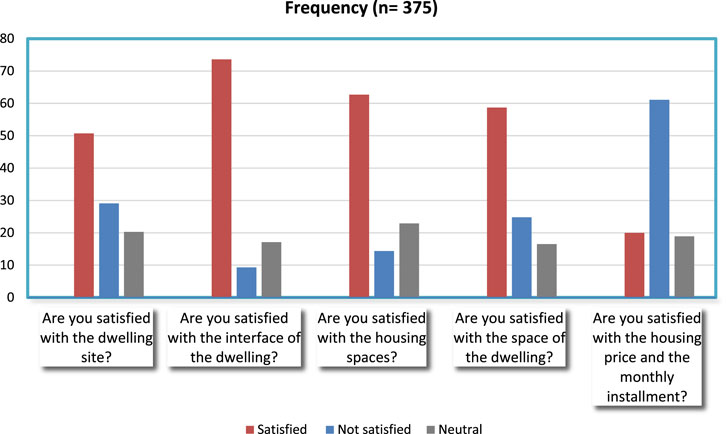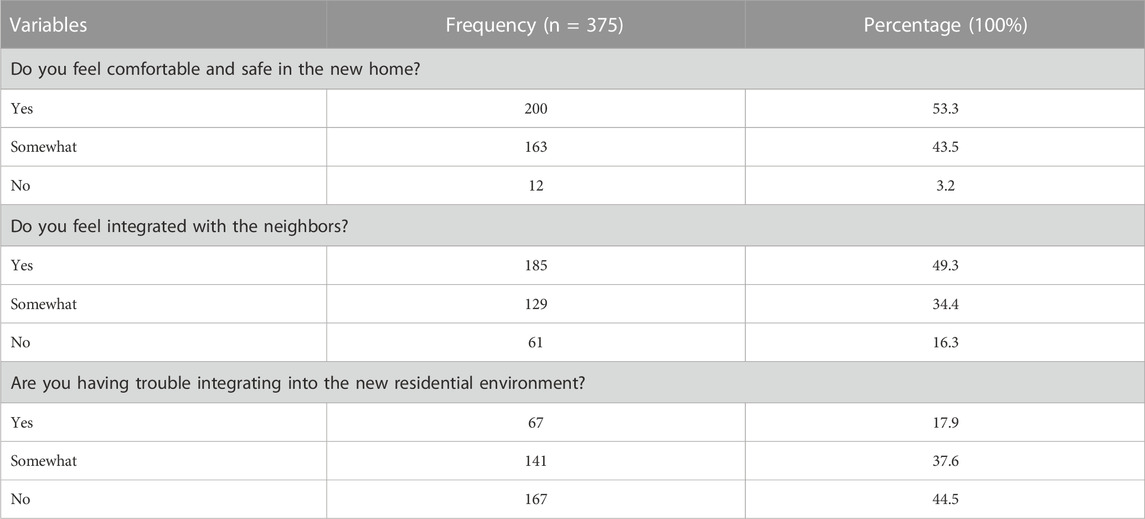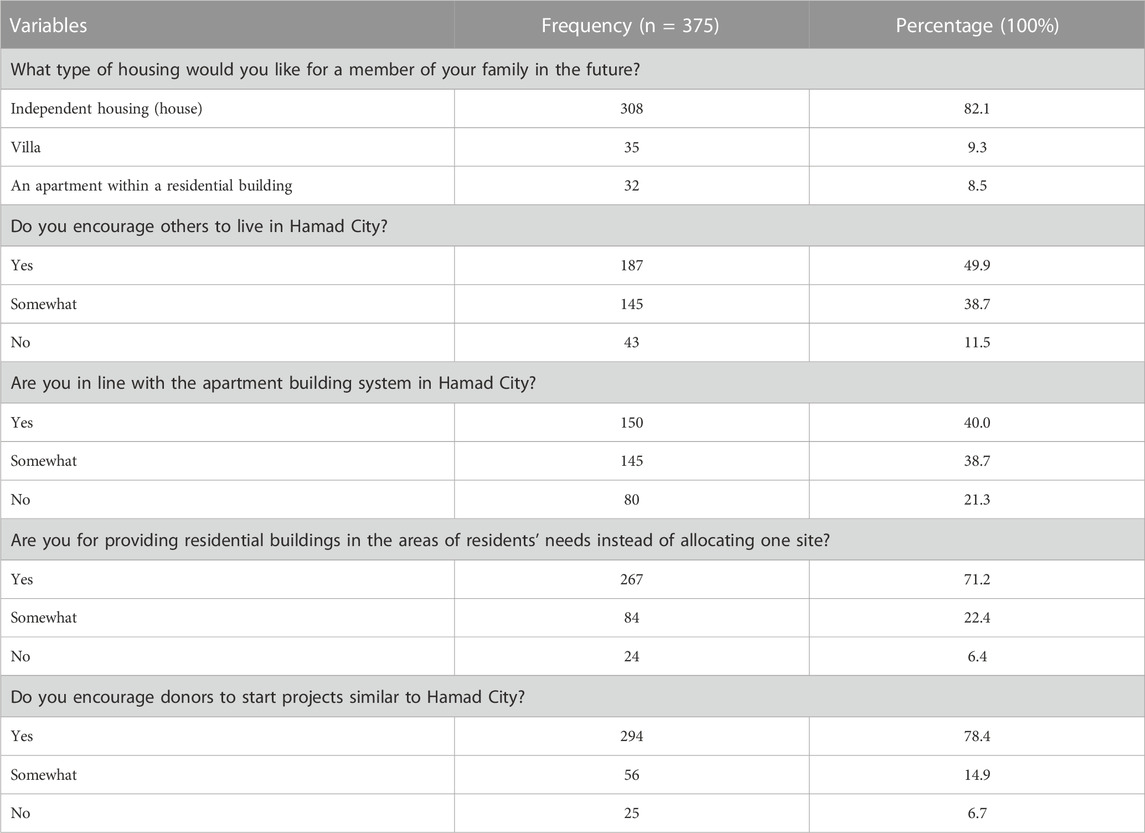- Geographic Information Systems (GIS) Department, Faculty of Information Technology, Arab American University, Jenin, Palestine
The internationally funded housing projects in Gaza Strip were initiated with the aim of providing secure and habitable housing for low-income families. Nevertheless, there remains a limited understanding of the level of satisfaction among residents dwelling in these housing units. This paper presents the outcomes of a survey conducted in Gaza Strip to assess residential satisfaction from international housing projects. This community-based cross-sectional descriptive study was conducted between October 2022 and March 2023. Data collection relied on a pre-tested structured questionnaire consisting of thirty-two items, and it targeted residents of Hamad City, an area within Gaza Strip where international housing projects are prevalent. The questionnaire encompassed inquiries into residents’ socio-demographic characteristics, their satisfaction levels regarding the dwelling, services, and the residential environment, their contentment with the social milieu, as well as their preferences and aspirations regarding future housing. To ascertain predictor variables influencing overall satisfaction with public housing, stepwise regression analysis were conducted, exploring their relationships with this overarching satisfaction factor. The survey encompassed a total of 375 participants residing in Hamad City. The results revealed that the overall average satisfaction rates with respect to the dwelling, services, and the residential environment were 53.1%, 52.9%, and 49.0%, respectively, among the residents of Hamad City in the Gaza Strip. Furthermore, 49.9% (n = 187) of the respondents expressed their inclination to recommend others to reside in Hamad City. Moreover, 40.0% (n = 150) of participants were content with the floor building system in Hamad City, while 71.2% (n = 267) concurred with the notion of allocating residential buildings based on residents’ needs instead of a single predetermined site. Impressively, 78.4% (n = 294) of the respondents encouraged donors to undertake projects akin to Hamad City. The regression analysis elucidated that overall satisfaction levels are predominantly influenced by the improvement in satisfaction pertaining to dwelling space sufficiency. Thus, a crucial recommendation emerging from this study is the consideration of augmenting dwelling space in forthcoming internationally funded housing projects, as this would significantly enhance overall residential satisfaction.
1 Introduction
1.1 Literature review
Residential satisfaction refers to the evaluation of one’s living conditions in light of personal needs, goals, and achievements (Amérigo and Aragones, 1997; Jansen, 2014). Existing literature on housing satisfaction underscores the multifaceted nature of factors influencing it. Research indicates that physical attributes of dwellings, such as size, layout, design, and maintenance significantly impact residential satisfaction (Zanuzdana et al., 2013). Additionally, neighborhood characteristics, encompassing safety, access to amenities, social cohesion, and aesthetics, are vital contributors to residents’ satisfaction levels (Wang et al., 2019). Socioeconomic factors, including income and education, have also been found to affect residential satisfaction (Diener et al., 2018). Furthermore, social relationships and support from neighbors contribute to elevated levels of satisfaction (Sundstrom et al., 2020). Conversely, the removal of social and institutional barriers for migrant integration into a city has been identified as an effective means to enhance residential satisfaction and neighborhood quality (Li and Wu, 2013). Psychological factors such as perceived control, attachment to place, and personal wellbeing are also associated with residential satisfaction (Manca et al., 2019). Additionally, some studies have indicated that housing quality, home ownership, community type, and socioeconomic status positively impact residential satisfaction, while the presence of children has a negative effect (Ren and Folmer, 2017). For a multitude of stakeholders, including architects, policymakers, and developers, studies on residential satisfaction have become crucial indicators. These studies serve four primary purposes as outlined by Galster (1985): first, they gauge how individuals perceive overall quality of life; second, they evaluate the success of housing developments, both public and private; third, they assess the initial stage of relocation and housing needs; and fourth, they measure residents’ dissatisfaction with their current living situations. A comprehensive understanding of residential satisfaction is essential for obtaining accurate information. (Galster, 1985).
Gaza Strip, part of Palestine, stands as one of the most densely populated areas, with an average density of 5,138 individuals per square kilometer (PCBS, 2022). This population density significantly influences housing provision and satisfaction levels, given the challenging living conditions stemming from a lack of essential services (Skaik, 2022). Gaza Strip grapples with a growing population, limited land and resources, and a severe housing shortage. The majority of residents reside in multi-story apartment buildings, often in overcrowded conditions, sharing small apartments with multiple family members. Furthermore, Israeli military operations have resulted in the destruction of Palestinian homes, exacerbating an already dire humanitarian crisis characterized by shortages of basic necessities such as food, water, and medical supplies (Rights, 2011; Asfour and Alsousi, 2016; Asfour, 2017).
In response to these challenges, various international organizations and NGOs have initiated affordable housing projects in Gaza. For instance, UNRWA has provided shelter assistance to Palestinian refugees in Gaza since 1950, with ongoing housing projects aimed at enhancing the living conditions of these families. Other organizations involved in housing projects in Gaza include the Qatar Fund for Development, the German Development Bank, and the Islamic Development Bank, among others. These projects seek to offer sustainable and affordable housing options to low-income families, contributing to the reconstruction and revitalization of Gaza following years of conflict and economic strain (Bahiri, 2019; Citaristi, 2022; PNGO, 2022).
In light of these circumstances, this study assesses residential satisfaction within international housing projects in the Gaza Strip, focusing on the Hamad City project in Khan Younis. This project was initiated to provide housing solutions for residents whose homes were demolished during various Israeli occupation wars and those with limited incomes. Consequently, this paper presents insights from a field study conducted among the beneficiaries of housing projects in Gaza, shedding light on the levels of satisfaction among residents in these new developments, as well as their aspirations and vision for future housing.
In order to discuss more relation between residential satisfaction and social wellbeing there are different studies collectively suggest that there is a relationship between enhanced housing satisfaction and social wellbeing. one of these is the study of Mouratidis (2020) which provided a systematic examination of how housing satisfaction with other life domains, relates to the different components of subjective wellbeing in side to other types of satisfaction such as neighborhood satisfaction the findings indicate that housing satisfaction was found to have a significant direct association with subjective wellbeing, as well as Zanuzdana et al. (2013) found that higher housing satisfaction was associated with higher income, education, and ownership of a dwelling. Another studies found that housing quality was associated with positive affect among the elderly population, mediated by place attachment (Evans et al., 2002). In addition to that Hashim (2003) study found that residents with high levels of residential satisfaction were actively involved in community activities, indicating social integration. Also Bratt (2010) study indicate that Housing constitutes a set of crucial for wellbeing of families, such as meet standards of decency and safety while actively participating in the family’s daily life as well as providing adequate space to prevent overcrowding, ensuring affordability, fostering opportunities for cultivating a positive sense of self and empowerment and offering stability and security. Moreover Etminani et al. (2017) study indicates a social association, cohesion and ties among residents will likely become less important when the planners overlook primary aspirations related to the physical aspects of public housing and access to essential services. However various studies support the correlation between enhanced housing satisfaction and social wellbeing, emphasizing the pivotal role of housing satisfaction in shaping overall social welfare. This underscores the necessity for policies and interventions aimed at enhancing resident life quality.
1.2 Purpose of the study
The study of residential satisfaction provides a comprehensive response by conducting an in-depth Assessment of Residential Satisfaction. The focus is on understanding the levels of contentment among residents residing in housing projects that have received international funding, with a particular emphasis on the facets of their living experience. Moreover, this study goes beyond a mere evaluation of physical infrastructure; it delves into the holistic wellbeing of the residents. The term “residential satisfaction” is not confined to the walls of a home but extends to encompass the overall quality of life, including socio-economic dimensions. Recognizing the significance of this holistic approach, the research aims to provide valuable insights for policymakers and decision-makers. By uncovering the nuanced dynamics of residents’ satisfaction, preferences, and aspirations, the study aims to inform the development of policies that go beyond basic housing needs. The goal is to guide future initiatives in a way that aligns with the community’s aspirations, promoting not only shelter but also community wellbeing. In addition to that the understanding well-designed and well-implemented housing projects can significantly contribute to the overall welfare of the community, this study positions itself as a conduit for advocating the importance of residents’ contentment. By accentuating the link between housing satisfaction and wellbeing, the research aspires to influence future projects positively, ensuring that they not only provide shelter but also foster a thriving and satisfied community. In this light, the ensuing exploration into residents’ socio-demographic characteristics, satisfaction levels, preferences, and aspirations aims to uncover nuanced insights that can inform policy, development, and decision-making processes. Through this study, we aspire to not only answer the question of residential satisfaction but also to contribute substantively to the ongoing dialogue on the optimization of internationally funded housing projects in the Gaza Strip, providing a knowledge base for policymakers to enhance the effectiveness of future initiatives.
2 Material and methods
2.1 Study context
The idea of establishing Hamad City in Gaza Strip dates back to 2012, when the former Emir of Qatar, Sheikh Hamad bin Khalifa Al Thani, donated it to the residents of the Strip during his visit to Gaza to see the devastation caused by the Israeli attack on the Strip. During the visit of Sheikh Hamad the Father, he donated about 407 million US dollars to the Gaza Strip in order to establish several vital projects, the most prominent of which was a residential city that includes about 2,500 apartments offered to the poor and toiling, the families of martyrs and those affected by the Israeli aggression, as mentioned at the beginning during the announcement of building the city. The project was a Qatari grant with clear criteria. It was being established on the liberated “settlements” lands west of Khan Yunis governorate in the south of Gaza Strip, currently classified as a government commons (Figure 1A). It was decided to build on an area of 1.26 km2, including 53 residential buildings with a height of 5 floors, containing about 3 thousand residential units. The project’s first phase included the construction of approximately 1,060 apartments, which were to be distributed free of charge to the groups, as mentioned earlier. At the same time, the second and third phases included 2,000 housing units (Figure 1B).
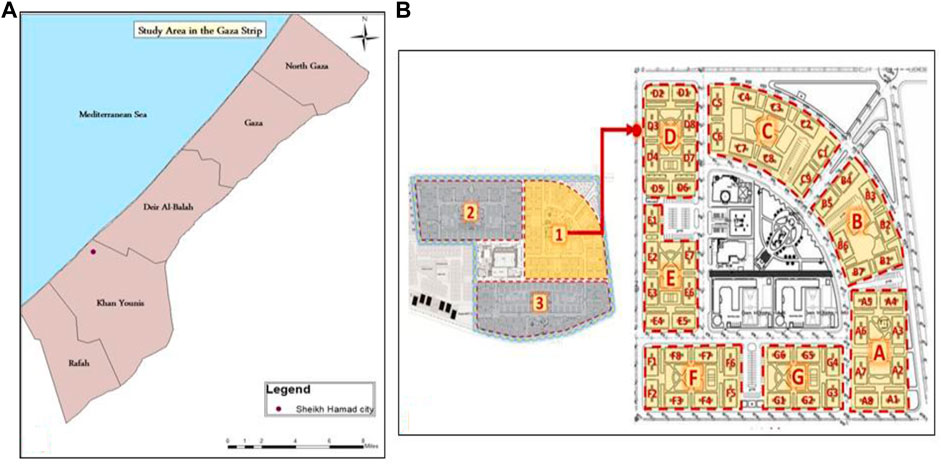
FIGURE 1. (A) Location of Sheikh Hamad on Gaza Strip map and (B) the general scheme of the Sheikh Hamad residential city for the three phases and the numbering of the buildings for the first phase.
Soon, the idea of selling apartments at reasonable prices took shape, and investing the money returned to build new apartments that would benefit the largest number of citizens. Still, that decision changed the target group from those in extreme poverty to people who could buy apartments at the offered prices. It is noteworthy that Hamad city was not the first case of its kind as a Gulf grant for Gazans affected by wars or those with limited incomes. Hamad City has an estimated population of about 15,000 people.
2.2 Study design and period
The current community-based cross-sectional descriptive study was conducted between October 2022 and March 2023.
2.3 Study tool and sampling process
A thirty-two item structured questionnaire was used to collect data on residential satisfaction in international housing projects. The questionnaire was created based on an earlier study conducted in Kuala Lumpur, Malaysia by Mohit et al. to assess the residential satisfaction in newly designed public low-cost housing (Mohit et al., 2010) (Figure 2).
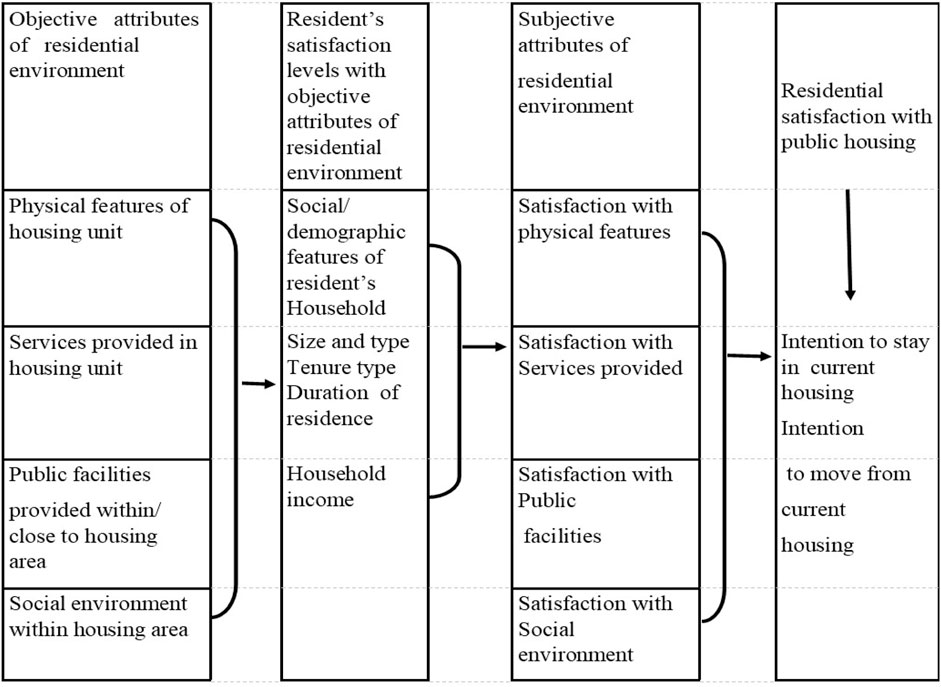
FIGURE 2. Conceptual model of residential satisfaction; Source (Mohit et al., 2010).
A 3-point Likert was used to measure respondents’ level of satisfaction on various housing components, where “1” = satisfied, “2” = neutral, “3” = dissatisfied (Table 1).
Three experts in the areas of residential happiness and housing policy confirmed the questionnaire’s content validity. The questionnaire was then evaluated by 45 people. Following the pilot testing, minor modifications were performed to guarantee its acceptability and consistency. Random sampling was applied to select 384 participants in Hamad City.
2.4 Eligibility criteria
The interviews were carried out only among people residing in Hamad City.
2.5 Sample size determination
The representative sample size in the present study was calculated using the following formula (Charan and Biswas, 2013):
Where Z1-α/2 = Standard normal variate (Z value is 1.96 for a 95 percent confidence level). p = Response distribution (50%). d = Margin of error (5%).
3 Data analysis
In order to guarantee the quality of data, each completed questionnaire was checked before it could be coded in MS Excel 2007. The Statistical Package for Social Science (SPSS) version 22 (IBM Corp, Armonk, NY, USA) was used for data analysis. Descriptive statistics were used to calculate the frequencies and percentages of the variables. Stepwise regression analysis was conducted to identify predictor variables that impact overall satisfaction with public housing by examining their relationship with this satisfaction factor.
4 Results
4.1 Characteristics of the study participants
A total of 375 participants who are residing in Hamad City were surveyed. The majority of the participants were males (86.4%). Less than half of the study participants 42.1% (n = 158) belong to the age group of 31–40 years old. About sixty 58.1% (n = 218) hold a bachelor’s degree, whereas only 1.6% received primary schooling. As far as previous residential venue is concerned, 61.1% (n = 229), 16.5% (n = 62), 9.6% (n = 36), 7.2% (n = 27), and 5.6% (n = 21) resided in Khan Younis, Gaza, Middle Area, Rafah, and Northern Gaza governorate before moving to Hamad City, respectively. Thinking about space and area of houses, 96.5% (n = 362) lived in an apartment of 100–130 square meters. Among them 62.9% (n = 236) of the study participants revealed that the space of the dwelling is sufficient. Actually, 91.7% (n = 344) mentioned that they had been selected to be benefited from Hamad residential project because they belonged to the limited income groups (Table 2).
4.2 Level of satisfaction with the dwelling
The overall percentage average of satisfaction with the dwelling among people who reside in Hamad City in the Gaza Strip was 53.1%. More than half of the study participants were satisfied with the residential site (50.7%). Yet, 73.6% (n = 276) were satisfied with the interface of the dwelling. At the same time, 62.7% (n = 235) were satisfied with the housing spaces. Then, 58.7% (n = 220) were satisfied with the space of the dwelling. But 61.1% were not with the housing price and the monthly installment (Figure 3). By the way, the overall level of satisfaction was calculated by considering the average of the sub-indicators within the evaluation system. Specifically, I computed the mean satisfaction scores for each sub-indicator related to the social environment, namely, feeling comfortable and safe in the new home, feeling integrated with neighbors, and any trouble integrating into the new residential environment. The average of these scores was then used to derive the overall percentage average of satisfaction with the social environment.
4.3 Level of satisfaction with the services and the residential environment
The overall percentage average of satisfaction with the services and the residential environment among people who reside in Hamad City in the Gaza Strip was 52.9%. Whereas 37.3% (n = 140) were satisfied with the educational services, 37.6% (n = 141) were not. A high number 80.8% (n = 303) were satisfied with garbage collection services and 68.5% (n = 257) were satisfied with the water services. Only 35.5% were satisfied with the electricity services. About transportation services just 46.1% (n = 173) showed satisfaction. But 85.9% (n = 322) were satisfied with sidewalks and walkways. Concerning recreation, 81.6% (n = 306) were satisfied with the availability of public parks and recreational spaces. Unfortunately, 13.6% (n = 51) were satisfied with the healthcare services. About banking, 42.1% (n = 158) were satisfied with the commercial services while 37.3% (n = 140) were satisfied with the noise level, but 33.6% (n = 126) were not (Table 3).
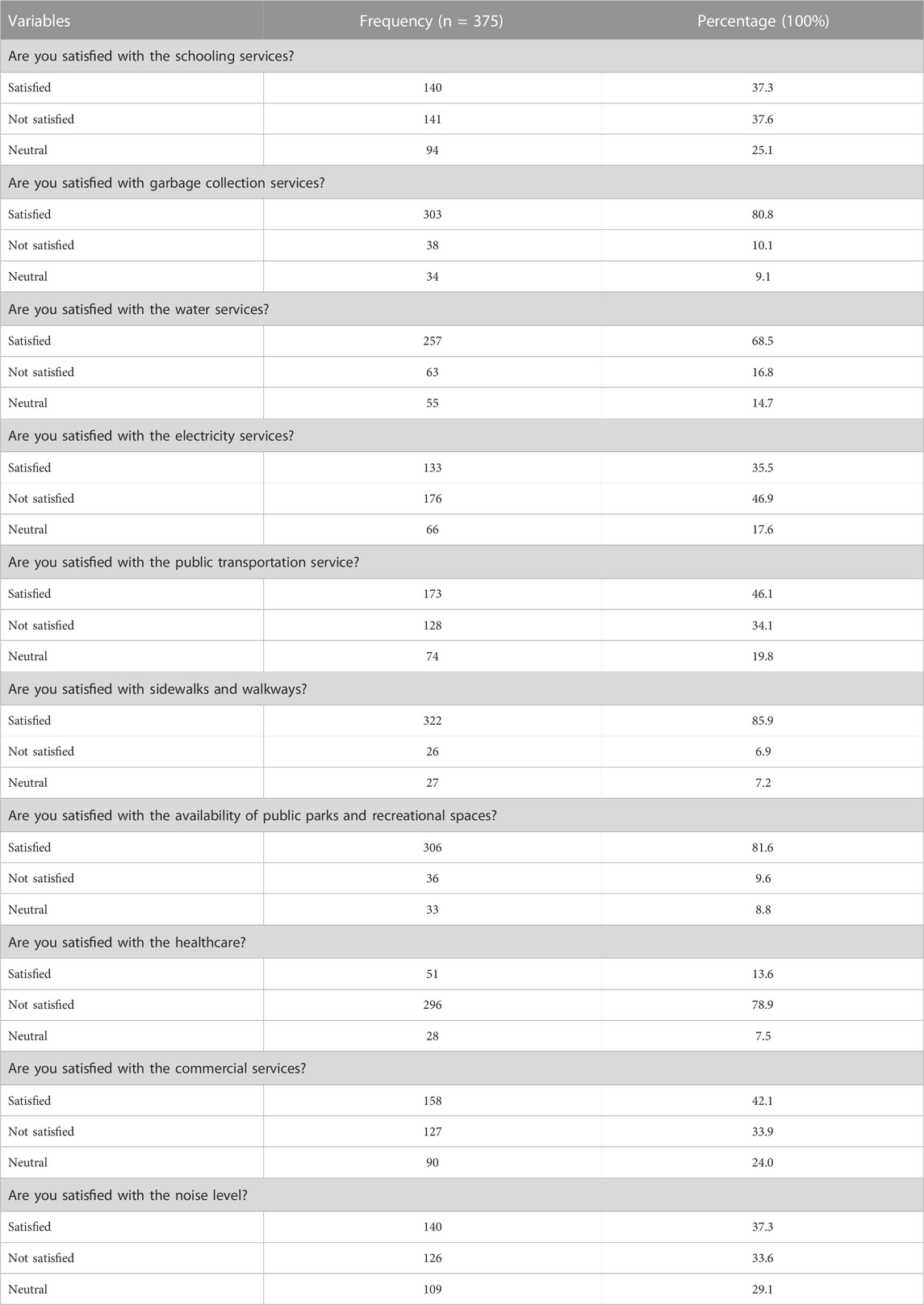
TABLE 3. Level of satisfaction with the services and the residential environment among the study participants.
4.4 Level of satisfaction with the social environment
The overall percentage average of satisfaction with the social environment among people who reside in Hamad City in Gaza Strip was 49.0%. More than half 53.3% (n = 200) of the study participants feel comfortable and safe in the new home, and 49.3% (n = 185) feel integrated with the neighbors, but only 17.9% (n = 67) have trouble integrating into the new residential environment (Table 4).
5 The desires for future housing
Regarding the desire for the type of future type of housing, 82.1% (n = 308), 9.3% (n = 35), and 8.5% (n = 32) of the study participants had a desire to reside in independent housing, villa, and an apartment within a residential building, respectively. Yet, 49.9% (n = 187) of the participants encourage others to live in Hamad city and 40.0% (n = 150) were comfortable with the apartment building system in Hamad city. The questionnaire revealed that 71.2% (n = 267) agreed with the opinion of the provision of residential buildings in the areas of residents’ needs instead of allocating one site and 78.4% (n = 294) encourage donors to establish construction projects similar to Hamad City (Table 5).
6 Factors determining overall satisfaction
The regression analysis (Table 6) reveals that the overall satisfaction levels are determined by enhancing satisfactions on dwelling space sufficiency. Therefore, to enhance overall satisfaction on future internationally funded projects in Gaza strip, it is important to consider the dwelling space sufficiency. With regard to the other factors the regression analysis assesses the impact of various factors on the overall satisfaction with the internationally funded Housing Projects in Hamad City. Where the constant represents the baseline level of overall satisfaction when all independent variables are zero. In this case, it is 1.435. The low p-value (0.000) indicates that this constant is significantly different from zero. Also, The age of the household head does not have a significant impact on overall satisfaction as indicated by the high p-value (0.982). The Beta value represents the standardized coefficient. In addition to that the negative coefficient suggests that as the educational level of the household head increases, overall satisfaction tends to decrease slightly, but this effect is not statistically significant (p-value = 0.185). furthermore, The residential governorate before moving does not significantly influence overall satisfaction, as indicated by the high p-value (0.828). And the positive coefficient suggests that as apartment space increases, overall satisfaction tends to increase slightly, but the effect is not statistically significant (p-value = 0.292). Here is the central factor, that is related to dwelling space sufficiency significantly impacts overall satisfaction (p-value = 0.000). The positive coefficient and high Beta value (0.281) indicate that as dwelling space sufficiency increases, overall satisfaction also increases. Lastly, the reason behind moving to Hamad City does not significantly influence overall satisfaction, as indicated by the high p-value (0.450).
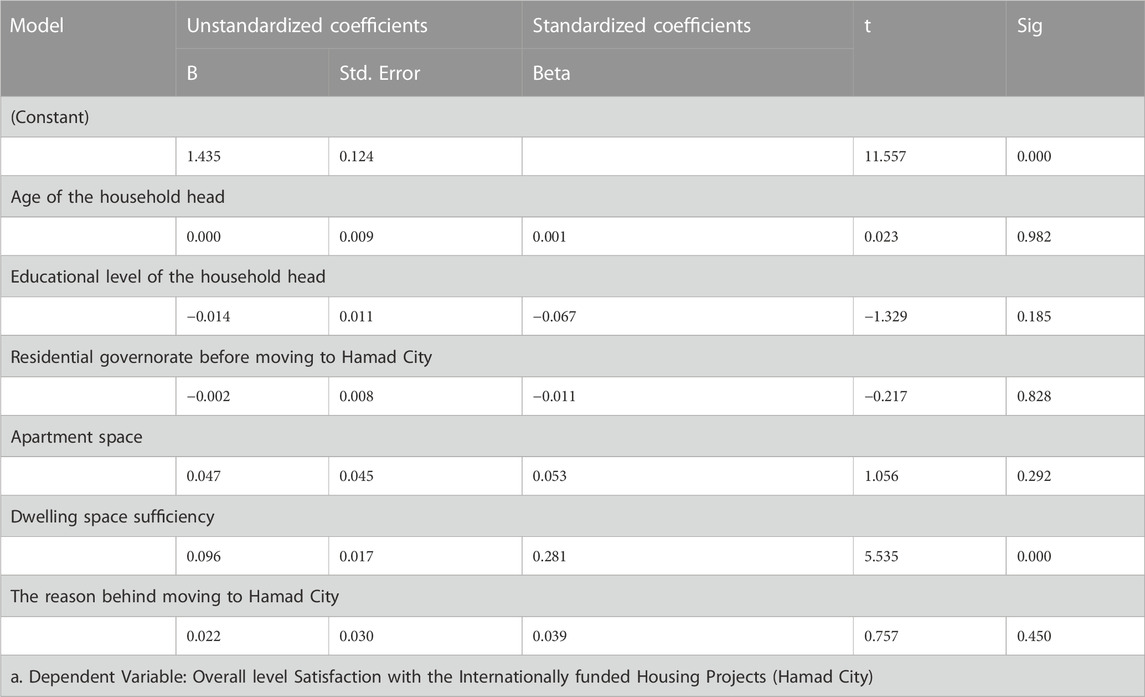
TABLE 6. Regression analysis of factors influencing overall satisfaction with the internationally funded Housing Projects (Hamad City).
7 Discussion
This study delves into several critical dimensions of residential satisfaction within the international housing projects of Hamad City, located in the densely populated Gaza Strip. We have explored demographic characteristics, levels of satisfaction across various domains, and residents’ housing desires for the future.
Gaza Strip stands as one of the most densely populated territories globally, accommodating approximately 2 million inhabitants within a mere 140 square miles. The majority of this population resides in international housing projects, originally established in the 1950s to shelter Palestinian refugees displaced during the 1948 Arab-Israeli War. Initially intended as temporary solutions by UNRWA, these projects have evolved into long-term housing solutions for many.
This study primary findings indicate that overall satisfaction levels in Hamad City among its residents are moderately positive, with satisfaction rates of 53.1% for the dwelling, 52.9% for services and the residential environment, and 49.0% for the social environment. Additionally, roughly half of the participants expressed an inclination to recommend Hamad City to others. It is important to note that residential satisfaction is a complex and context-dependent cognitive construct influenced by a multitude of factors, including specific location, time, evaluative goals, and the individuals involved (Mohit and Raja, 2014). Residential satisfaction, as a subjective construct, is challenging to measure comprehensively, given its subjectivity and susceptibility to variation based on context and individual perspectives (Bardo and Dökmeci, 1992). Also the literature on home satisfaction has produced a diverse array of findings, reflecting the multifaceted nature of this concept. So, the moderate overall satisfaction levels among Hamad City residents, indicate a nuanced perspective on the success of international housing projects. While the majority express satisfaction with dwelling space and certain aspects of the residential environment, notable concerns exist, particularly regarding housing prices, monthly installments, and some service provisions. This suggests that the success of such projects is contingent on a multifaceted evaluation that extends beyond physical dwelling attributes. Also by extrapolating insights gained from Hamad City, the study can contribute to discussions surrounding the effectiveness of housing projects in similar densely populated regions globally. The challenges faced by residents, such as those related to services, infrastructure, and socioeconomic factors, may resonate with populations in other international housing projects.
It is worthwhile to mention that a UNRWA study highlights the variable nature of residential satisfaction among residents in international housing projects in Gaza Strip. This variability stems from diverse perceptions with some expressing satisfaction with living conditions while others report dissatisfaction regarding construction quality, amenities, services, and overcrowding. Issues related to basic services, notably water and electricity shortages, have significant repercussions on daily life and residents’ contentment. The need for proper maintenance and infrastructure repair also emerges as a prevalent concern. However, residents often value the safety, security, and sense of community offered by these housing projects (Bahiri, 2019).
This study seeks to explore multiple indicators of housing satisfaction, encompassing physical aspects like dwelling space, façade, and location, as well as various services including education, commerce, garbage and sewage management, public transportation, recreational areas, and utility services. Additionally, we delve into the social environment indicators, including residents’ comfort in their new homes, integration with neighbors, feelings of safety, and their perceived distancing from old acquaintances and neighbors. This comprehensive approach provides a nuanced understanding of the factors influencing residential satisfaction and residents’ aspirations for future housing.
This study provides valuable insights into the level of residential satisfaction within international housing projects in Gaza Strip. While these projects have effectively provided secure and decent housing, significant challenges remain, particularly regarding the provision of essential services and maintenance. The safety and sense of community fostered by these housing projects are appreciated by many residents. We emphasize that the level of residential satisfaction among these residents is influenced by various factors, including access to basic amenities, housing quality, infrastructure, and access to healthcare and education. Policymakers and international organizations should prioritize addressing these factors to enhance the quality of life for Gaza Strip residents. The regression analysis underscores that overall satisfaction levels are notably influenced by dwelling space sufficiency. Therefore, to enhance satisfaction in future internationally funded housing projects in Gaza Strip, careful consideration of dwelling space adequacy is essential.
The strength of the study lies in its novelty, as it is the first to assess international housing projects in Gaza Strip, specifically within Hamad City. Nonetheless, there are limitations to consider, including the cross-sectional design, which precludes establishing causal relationships and limits generalizability. Additionally, this study focused solely on Hamad City, one of the international housing projects in Gaza Strip. Future research should aim to encompass all such projects, in order to provide a more comprehensive understanding of residential satisfaction in this unique context. The identified factors influencing overall satisfaction, particularly the emphasis on dwelling space sufficiency, carry implications for the design and implementation of future housing projects. Policymakers, international organizations, and urban planners should take heed of the nuanced interplay between physical attributes, services, and socio-economic considerations when conceptualizing and executing housing initiatives. The study’s findings in Hamad City offer insights that could have implications for international practices in housing satisfaction, especially in regions facing similar challenges. While Gaza Strip has its unique socio-political context, certain universal factors influencing residential satisfaction emerge from this research. The study highlights challenges in the provision of essential services, such as water and electricity shortages, impacting residents’ satisfaction. This resonates with issues faced by communities in various regions globally. As well as the emphasis on the safety, security, and sense of community valued by residents in international housing projects is a universal theme. This finding underscores the importance of fostering a sense of belonging and security in housing initiatives worldwide. Understanding and prioritizing these factors can contribute to the success and sustainability of housing projects in diverse contexts. Moreover, The study reaffirms the influence of socioeconomic factors, including income and education, on residential satisfaction. This is a universal consideration applicable to housing projects globally. Tailoring housing solutions to accommodate the economic and educational diversity of residents is crucial for fostering satisfaction and wellbeing. In addition to that the regression analysis underscores the significance of dwelling space sufficiency in overall satisfaction. This finding is transferable to housing projects globally, emphasizing the need to prioritize adequate living spaces to enhance residents’ overall contentment. While acknowledging the specificities of each region, the identified factors influencing residential satisfaction in Hamad City can serve as a framework for international practices in housing initiatives. Policymakers, involved in housing projects worldwide can draw upon these insights to create more tailored and effective solutions, ultimately contributing to improved quality of residents life.
8 Conclusion
This study has illuminated the impact of the Hamad City housing project in Khan Younis, Gaza Strip, in offering secure and habitable housing, thereby contributing to elevate levels of satisfaction among its residents. Moreover, we have identified critical challenges related to the availability of basic services and the maintenance and repair of buildings and infrastructure which significantly influence residents’ satisfaction. Furthermore, the findings underscore the importance of living space sufficiency as a determinant of residential satisfaction. Therefore, I recommend that future internationally funded housing projects give due consideration to expanding dwelling space as a strategic measure to enhance overall satisfaction among residents. These insights have broader implications for housing development efforts in similar contexts, emphasizing the need to address both infrastructure challenges and dwelling space adequacy to improve the quality of life for residents. In order to improve existing situation in Hamad City it should prioritize upgrading essential services, including water and electricity provisions. Social interaction and community engagement should be fostered through initiatives that promote neighborly connections and social activities within the housing projects. Furthermore, there is a need to address infrastructure challenges, particularly those related to basic amenities, housing quality, and accessibility to healthcare and education. By integrate sustainable development practices with community activities, this includes environmental considerations, and eco-friendly initiatives to create a more sustainable and resilient living environment.
Data availability statement
The raw data supporting the conclusion of this article will be made available by the authors, without undue reservation.
Ethics statement
The Deanship of Scientific Research approved the study protocol at the Arab American. University (SRD:22/23-O-065). Written permission was sought and granted by the Palestinian Ministry of Interior to carry out the study. Written informed consent to participate in this study was provided by the study participants.
Author contributions
FS: Conceptualization, Formal Analysis, Funding acquisition, Methodology, Project administration, Resources, Software, Supervision, Validation, Visualization, Writing–original draft, Writing–review and editing.
Funding
The author(s) declare that no financial support was received for the research, authorship, and/or publication of this article.
Acknowledgments
The author would like to thank the Deanship of Scientific Research at the Arab American University and the Palestinian Ministry of Interior and National Security for the facilitation of conducting this study. The author is also grateful to the participants for their valuable participation in this study. The author thanks Dr. Samer Abu zerr for his help in the data collection process.
Conflict of interest
The author declares that the research was conducted in the absence of any commercial or financial relationships that could be construed as a potential conflict of interest.
Publisher’s note
All claims expressed in this article are solely those of the authors and do not necessarily represent those of their affiliated organizations, or those of the publisher, the editors and the reviewers. Any product that may be evaluated in this article, or claim that may be made by its manufacturer, is not guaranteed or endorsed by the publisher.
References
Amérigo, M., and Aragones, J. I. (1997). A theoretical and methodological approach to the study of residential satisfaction. J. Environ. Psychol. 17 (1), 47–57. doi:10.1006/jevp.1996.0038
Asfour, O. S. (2017). The role of land planning policies in supporting housing affordability: the case of the Gaza Strip. Land Use Policy 62, 40–48. doi:10.1016/j.landusepol.2016.12.018
Asfour, O. S., and Alsousi, R. M. (2016). Exploring residents’ attitude towards implementing housing design flexibility in the Gaza strip. J. Eng. Res. Technol. 3 (2).
Bahiri, S. (2019). Construction and housing in the west bank and Gaza. New York: Routledge. ISBN: 0429714467.
Bardo, J., and Dökmeci, V. (1992). Modernization, traditionalism, and the changing structure of community satisfaction in two sub-communities in Istanbul, Turkey: a Procrustean analysis. Genet. Soc. general Psychol. Monogr. 118 (3), 271–292.
Bratt, R. (2010). Housing and family well-being. Hous. Stud. 17 (1), 13–26. doi:10.1080/02673030120105857
Charan, J., and Biswas, T. (2013). How to calculate sample size for different study designs in medical research? Indian J. Psychol. Med. 35 (2), 121–126. doi:10.4103/0253-7176.116232
Citaristi, I. (2022). United nations human settlements programme—UN-habitat. The Europa Directory of International Organizations 2022, 240–243. Routledge.
Diener, E., Lucas, R. E., and Oishi, S. (2018). Advances and open questions in the science of subjective well-being. Collabra Psychol. 4 (1), 15. doi:10.1525/collabra.115
Etminani, R., Majedi, H., and Paydar, M. (2017). Assessment of residential satisfaction in mehr housing scheme: a case study of sadra new town, Iran. Hous. Theory Soc. 34 (11), 1–20.
Evans, G., Kantrowitz, E., and Eshelman, P. (2002). Housing quality and psychological well-being among the elderly population. J. Gerontology Psychol. Sci. 57 (4), 381–383. doi:10.1093/geronb/57.4.p381
Galster, G. C. (1985). Evaluating indicators for housing policy: residential satisfaction vs marginal improvement priorities. Soc. Indic. Res. 16, 415–448. doi:10.1007/bf00333289
Hashim, A. (2003). Residential satisfaction and social integration in public low cost housing in Malaysia. Pertanika J. Sosial Sci. Humanit. 11 (1), 1–10.
Jansen, S. J. (2014). Why is housing always satisfactory? A study into the impact of cognitive restructuring and future perspectives on housing appreciation. Soc. Indic. Res. 116 (2), 353–371. doi:10.1007/s11205-013-0303-1
Li, Z., and Wu, F. (2013). Residential satisfaction in China's informal settlements: a case study of Beijing, Shanghai, and Guangzhou. Urban Geogr. 34 (7), 923–949. doi:10.1080/02723638.2013.778694
Manca, S., Cerina, V., and Fornara, F. (2019). Residential satisfaction, psychological well-being and perceived environmental qualities in high-vs. low-humanized residential facilities for the elderly. Soc. Psychol. Bull. 14 (2), 1–15. doi:10.32872/spb.v14i2.33570
Mohit, M. A., Ibrahim, M., and Rashid, Y. R. (2010). Assessment of residential satisfaction in newly designed public low-cost housing in Kuala Lumpur, Malaysia. Habitat Int. 34 (1), 18–27. doi:10.1016/j.habitatint.2009.04.002
Mohit, M. A., and Raja, A. M. M. A.-K. (2014). Residential satisfaction-concept, theories and empirical studies. Plan. Malays. 12 (3). doi:10.21837/pmjournal.v12.i3.131
Mouratidis, K. (2020). Commute satisfaction, neighborhood satisfaction, and housing satisfaction as predictors of subjective well-being and indicators of urban livability. Travel Behav. Soc. 21, 265–278. doi:10.1016/j.tbs.2020.07.006
PCBS (2022). Developing societal thought for the components of contemporary housing. Palestinian Central Bureau of Statistics. https://www.pcbs.gov.ps/site/512/default.aspx?lang=en&ItemID=4333.
PNGO (2022). During workshop organized by PNGO: an integrated strategy for social protection and proper housing in the Gaza Strip is to be developed. Palestine: Palestinian Non-Governmental Organizations Network. Available at: https://en.pngoportal.org/post/3604/During-workshop-organized-by-PNGO-An-integrated-strategy-for-social-protection-and-proper-housing-in-the-Gaza-Strip-is-to-be-developed.
Ren, H., and Folmer, H. (2017). Determinants of residential satisfaction in urban China: a multi-group structural equation analysis. Urban Stud. 54 (6), 1407–1425. doi:10.1177/0042098015627112
Rights, H. (2011). New projects to ease Gaza housing crisis. Journalism from the heart of crises. Available at: https://www.thenewhumanitarian.org/feature/2011/10/25/new-projects-ease-gaza-housing-crisis.
Skaik, M. (2022). The reality of the housing sector in the Gaza strip “challenges – recommendations”. This paper was prepared as part of the project “channels of developing community needs within a rapid population growth in the Gaza strip” implemented by: Palestinian NGO’s network in partnership with: friedrich-ebert-stiftung, Palestine. Available at: https://palestine.fes.de/fileadmin/user_upload/Publication_1/PNGO/PNGO_2022/Reality_of_the_Housing_Sector_in_the_Gaza_Strip.pdf.
Sundstrom, B., DeMaria, A. L., Ferrara, M., Smith, E., and McInnis, S. (2020). “People are struggling in this area:” a qualitative study of women’s perspectives of telehealth in rural South Carolina. Women & Health 60 (3), 352–365. doi:10.1080/03630242.2019.1643814
Wang, D., Schwanen, T., and Mao, Z. (2019). Does exposure to richer and poorer neighborhoods influence wellbeing? Cities 95, 102408. doi:10.1016/j.cities.2019.102408
Keywords: residential satisfaction, international housing projects, Gaza Strip, Hamad City, Palestine
Citation: Sabah FY (2023) Assessment of residential satisfaction with internationally funded housing projects in Gaza Strip, Palestine. Front. Built Environ. 9:1289707. doi: 10.3389/fbuil.2023.1289707
Received: 06 September 2023; Accepted: 22 November 2023;
Published: 05 December 2023.
Edited by:
Shixian Luo, Southwest Jiaotong University, ChinaReviewed by:
Ali Abdelhamid, An-Najah National University, PalestineJiao Zhang, The University of Tokyo, Japan
Copyright © 2023 Sabah. This is an open-access article distributed under the terms of the Creative Commons Attribution License (CC BY). The use, distribution or reproduction in other forums is permitted, provided the original author(s) and the copyright owner(s) are credited and that the original publication in this journal is cited, in accordance with accepted academic practice. No use, distribution or reproduction is permitted which does not comply with these terms.
*Correspondence: Faisal Yousef Sabah, ZmFpc2FsLnNhYmFoQGFhdXAuZWR1
 Faisal Yousef Sabah
Faisal Yousef Sabah

